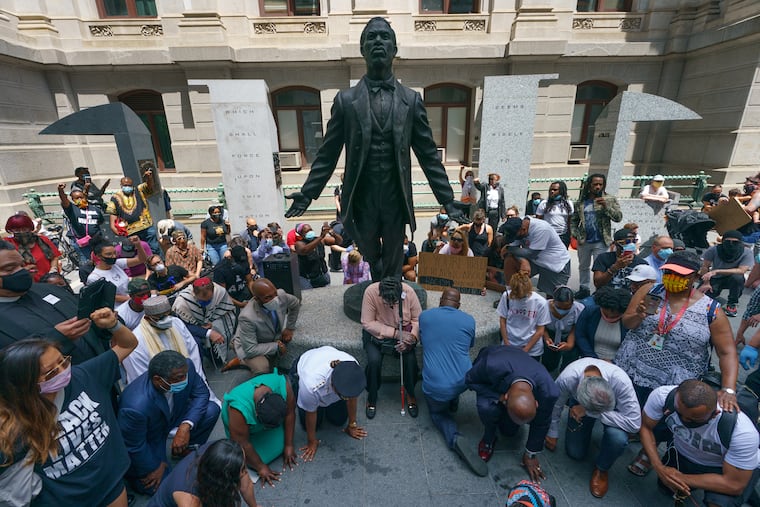We finally removed a racist statue in Philly. What comes next for our public art? | Opinion
The Rizzo statue is not an aberration, but the tip of the iceberg.

Now that the Frank Rizzo statue has come down, it is time to envision a long-awaited next chapter for our city.
From the statue’s dedication in 1999, the larger-than-life bronze figure loomed over the civic spaces around City Hall. Installed less than a decade after Rizzo’s death, the city enshrined the former mayor and police commissioner, whose approaches to “law and order” included tormenting black Philadelphians during the Civil Rights Movement, raiding gay bars and businesses in the pre-Stonewall era, and flouting constitutional rights, among a litany of degradations directed against residents of the city.
The Rizzo statue’s placement on the front steps of the Municipal Services Building compounded the wounds of his legacy with the ongoing discrimination, displacement, and hyper-surveillance of black and brown communities. Ultimately, the statue served as a monument to entrenched white supremacy.
The elevation of hometown “heroes” is never impartial. In this case, the Rizzo statue celebrated and protected violent forms of white domination and control in the heart of the city. Its takedown is part of ongoing movements to reckon with the symbols and systems of racism and follows years of organizing and testimony around the statue led by black activists, including the Philadelphia Coalition for REAL (Racial, Economic and Legal) Justice. Others followed suit to emphatically point out the harm done by the continued presence and financial resources leveraged to keep the statue in place.
The most recent protests in defense of black lives and against police brutality made it impossible for the city to delay its promised removal any further.
The takedown of Rizzo, like this week’s removal of Robert E. Lee and Confederate monuments across from Birmingham, Ala.’s City Hall and on Richmond, Va.’s Monument Avenue, among dozens of other locales, confirm that exclusion has been built into our public spaces.
Public art is part of Philadelphia’s DNA. At our best, it can be a guiding voice and a platform for democratic belonging. But with a collection of over 1,500 statues to historic figures, we continue to maintain profound inequities of monumental representation. There is only one full statue to a named historic person of color on public land — Octavius V. Catto, a 19th-century black freedom fighter and educator — in this city.
Right now we must work to not just fill the empty place once occupied by the Rizzo statue, but reenvision the power structures that landed it there in the first place.
At a time when we desperately need official outlets for public art, the city’s public art office would “cease to exist” in the mayor’s proposed budget. This is cause for alarm, because the roots of Philadelphia’s art history, including the Rizzo statue, run deep into the municipal systems that produced the monument and kept it in place for decades.
Now, as our city strives to respond to protests against racial injustice, our approach to civic art must, too, must reflect a radical reenvisioning toward justice, repair, and regrowth.
Philadelphia has a responsibility to be bolder in our art and demands of freedom.
This means to support artists, especially black artists, who deserve time, space, and financial resources to imagine the monuments our city deserves. This can include reconsideration of Hank Willis Thomas’ All Power to All People, placed as a prototype monument adjacent to the Rizzo statue, as part of our Monument Lab exhibition in 2017 with Mural Arts Philadelphia. (Thomas’ monument is now in the collection of the nearby Pennsylvania Academy of the Fine Arts — and could be considered for a return to MSB Plaza.)
Art is a vehicle for change. Rizzo is not an aberration, but the tip of the iceberg. We cannot treat its takedown as proof of a fix or resolution, but as a precondition of the necessary changes we have yet to make.
What comes next? If we treat the takedown not as a culmination, but a continuation, we just may start to move toward something transformative for our city.
Paul M. Farber is the artistic director of Monument Lab and senior research scholar at the Center for Public Art and Space at the University of Pennsylvania Stuart Weitzman School of Design. He is the co-editor of “Monument Lab: Creative Speculations for Philadelphia.”